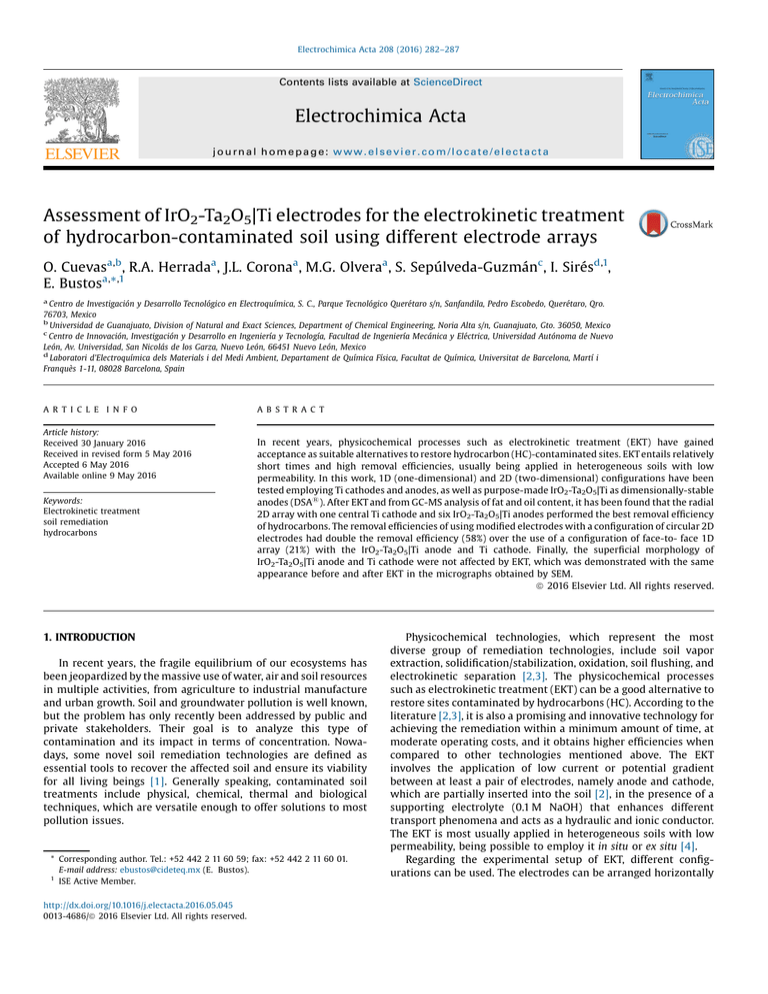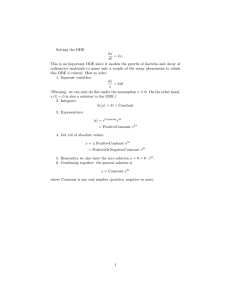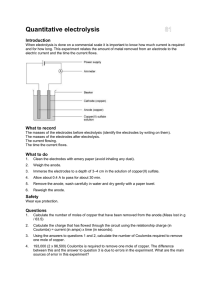
Electrochimica Acta 208 (2016) 282–287
Contents lists available at ScienceDirect
Electrochimica Acta
journal homepage: www.elsevier.com/locate/electacta
Assessment of IrO2-Ta2O5|Ti electrodes for the electrokinetic treatment
of hydrocarbon-contaminated soil using different electrode arrays
O. Cuevasa,b , R.A. Herradaa , J.L. Coronaa , M.G. Olveraa , S. Sepúlveda-Guzmánc, I. Sirésd,1,
E. Bustosa,* ,1
a
Centro de Investigación y Desarrollo Tecnológico en Electroquímica, S. C., Parque Tecnológico Querétaro s/n, Sanfandila, Pedro Escobedo, Querétaro, Qro.
76703, Mexico
b
Universidad de Guanajuato, Division of Natural and Exact Sciences, Department of Chemical Engineering, Noria Alta s/n, Guanajuato, Gto. 36050, Mexico
c
Centro de Innovación, Investigación y Desarrollo en Ingeniería y Tecnología, Facultad de Ingeniería Mecánica y Eléctrica, Universidad Autónoma de Nuevo
León, Av. Universidad, San Nicolás de los Garza, Nuevo León, 66451 Nuevo León, Mexico
d
Laboratori d’Electroquímica dels Materials i del Medi Ambient, Departament de Química Física, Facultat de Química, Universitat de Barcelona, Martí i
Franquès 1-11, 08028 Barcelona, Spain
A R T I C L E I N F O
Article history:
Received 30 January 2016
Received in revised form 5 May 2016
Accepted 6 May 2016
Available online 9 May 2016
Keywords:
Electrokinetic treatment
soil remediation
hydrocarbons
A B S T R A C T
In recent years, physicochemical processes such as electrokinetic treatment (EKT) have gained
acceptance as suitable alternatives to restore hydrocarbon (HC)-contaminated sites. EKT entails relatively
short times and high removal efficiencies, usually being applied in heterogeneous soils with low
permeability. In this work, 1D (one-dimensional) and 2D (two-dimensional) configurations have been
tested employing Ti cathodes and anodes, as well as purpose-made IrO2-Ta2O5|Ti as dimensionally-stable
anodes (DSA1). After EKT and from GC-MS analysis of fat and oil content, it has been found that the radial
2D array with one central Ti cathode and six IrO2-Ta2O5|Ti anodes performed the best removal efficiency
of hydrocarbons. The removal efficiencies of using modified electrodes with a configuration of circular 2D
electrodes had double the removal efficiency (58%) over the use of a configuration of face-to- face 1D
array (21%) with the IrO2-Ta2O5|Ti anode and Ti cathode. Finally, the superficial morphology of
IrO2-Ta2O5|Ti anode and Ti cathode were not affected by EKT, which was demonstrated with the same
appearance before and after EKT in the micrographs obtained by SEM.
ã 2016 Elsevier Ltd. All rights reserved.
1. INTRODUCTION
In recent years, the fragile equilibrium of our ecosystems has
been jeopardized by the massive use of water, air and soil resources
in multiple activities, from agriculture to industrial manufacture
and urban growth. Soil and groundwater pollution is well known,
but the problem has only recently been addressed by public and
private stakeholders. Their goal is to analyze this type of
contamination and its impact in terms of concentration. Nowadays, some novel soil remediation technologies are defined as
essential tools to recover the affected soil and ensure its viability
for all living beings [1]. Generally speaking, contaminated soil
treatments include physical, chemical, thermal and biological
techniques, which are versatile enough to offer solutions to most
pollution issues.
* Corresponding author. Tel.: +52 442 2 11 60 59; fax: +52 442 2 11 60 01.
E-mail address: ebustos@cideteq.mx (E. Bustos).
ISE Active Member.
1
http://dx.doi.org/10.1016/j.electacta.2016.05.045
0013-4686/ã 2016 Elsevier Ltd. All rights reserved.
Physicochemical technologies, which represent the most
diverse group of remediation technologies, include soil vapor
extraction, solidification/stabilization, oxidation, soil flushing, and
electrokinetic separation [2,3]. The physicochemical processes
such as electrokinetic treatment (EKT) can be a good alternative to
restore sites contaminated by hydrocarbons (HC). According to the
literature [2,3], it is also a promising and innovative technology for
achieving the remediation within a minimum amount of time, at
moderate operating costs, and it obtains higher efficiencies when
compared to other technologies mentioned above. The EKT
involves the application of low current or potential gradient
between at least a pair of electrodes, namely anode and cathode,
which are partially inserted into the soil [2], in the presence of a
supporting electrolyte (0.1 M NaOH) that enhances different
transport phenomena and acts as a hydraulic and ionic conductor.
The EKT is most usually applied in heterogeneous soils with low
permeability, being possible to employ it in situ or ex situ [4].
Regarding the experimental setup of EKT, different configurations can be used. The electrodes can be arranged horizontally
O. Cuevas et al. / Electrochimica Acta 208 (2016) 282–287
or vertically on the x-y spatial plane. Most laboratory or pilot EKT
studies are carried out in two dimensional configurations (2D,
Fig. 1A). In this experimental set, the central electrode is the
cathode and the anode corresponds with a radial zone comprised
of six identical electrodes, as well as in the one dimensional arrays
(1D, Fig. 1B). The plate-shaped electrodes correspond to the
cathode ( ) and the anode (+) facing each other at a certain
distance [3,5]. Electroremediation involves passage through soil of
direct current between appropriately distributed electrodes. The
technique can be performed in situ and is effective for fine-grained
soils of low hydraulic permeability, which are difficult to treat by
other methods. Its advantages include close control over the
direction of movement of water and dissolved contaminants, even
though heterogeneous soils, retention of contaminants within a
283
confined zone, and low power consumption. Mechanisms by
which water and solutes are transported through soils under
applied electrical fields may involve several contributory processes
whose relative importance varies from one system to another. For
molecular substances, electro-osmosis is the predominant form of
transport under an electric field, although partial dissociation into
ions of some organic molecules will result in electromigration as
well [6].
Although the EKT seems to be quite simple, there are several
physicochemical factors influencing the transport of pollutants
and, consequently, the effectiveness of the remediation. Among the
main factors, the occurrence of oxidation and reduction reactions
as a result of the application of electrical current is primary, and
depends on the nature of the electrodes used. Sometimes, cheap
materials such as iron, steel or graphite are preferred [6]. However,
in order to avoid introducing contaminants into the system inert
substrate materials such as titanium having an electrocatalytic
coating composed of metal oxides, so-called dimensionally-stable
anodes (DSA1), are generally chosen [3,7,8]. The structure of the
electrodes must be porous to ensure good contact with the
electrolyte and favor the release of the gases produced from water
electrolysis [6]. Whereas their size, shape and interelectrode
distance affect the removal rates [9]. DSA1 electrodes enhance the
kinetics, favoring the thermodynamic control at interfacial level,
which improves their performance and selectivity, and provides
corrosion protection, among other benefits. DSA1 has been widely
used for chlorine production, electroplating, organic synthesizing
and wastewater treatment [10–13]. Minerals other than Ti, Zr, and
Ta can also be used as substrates to deposit different oxides like
IrO2, RuO2 and SnO2 [14–16].
In the present investigation, IrO2-Ta2O5|Ti anodes made by
painting, followed by thermal decomposition, have been used in
the electrokinetic treatment of real HC-contaminated Vertisol soil,
which has not been reported before. Both, 1D (linear) and 2D
(radial) configurations have been compared in terms of fats and
oils removed at different regions of the reactor. Ti anodes have
been used as well for comparison, and the effect of EKT on the
morphology of both kinds of anodes has been assessed by scanning
electron microscopy coupled to energy-dispersive X-ray spectroscopy (SEM-EDX).
2. EXPERIMENTAL
2.1. Construction and characterization of IrO2-Ta2O5|Ti
Fig. 1. Experimental setups: (A) Radial 2D array with one central cathode and six
surrounding anodes with cylindrical shape (1.0 5.0 cm); (B) Linear 1D array with
one cathode and one anode facing each other with planar shape (5.3 2.5 0.2 cm).
Electrode materials: Ti as cathode ( ) and Ti or IrO2-Ta2O5|Ti (DSA1) as anode (+),
with a separation of 6 cm between them.
Titanium (ASTM grade 2) was employed as a substrate for
preparing the DSA1. Ti plates (5.3 2.5 0.2 cm) and cylinders
(1.0 5.0 cm) were sandblasted [13,15,17,18]. The substrates were
etched with a 40% oxalic acid solution for 20 min [13,15,19,20], then
rinsed with deionized water and finally dried. The main objective
of the pretreatment was to increase the electrode surface area and
promote a better anchorage of the modifier solution.
For the electrode synthesis, the modifier solution was prepared
by dissolving H2IrCl6 (Strem Chemicals, 99.9%) [15,17,18,20] in
hydrochloric acid [11,13], and TaCl5 (Strem Chemicals, 99.9%) in
isopropanol [13,17,18]. Both solutions were mixed and the metal
weight ratio (Ir:Ta) in the precursor solution was 20:80. Finally, the
modifier solution was applied to the pretreated titanium
substrates using a brush [13,15]. Metal oxides were obtained by
thermal decomposition in two steps: the first one, at 523 K for
10 min, followed by a second one, at 723 K for 1 h [13,17,18].
The morphology of DSA1 electrodes was evaluated by obtaining
micrographs through scanning electron microscopy (SEM) using a
JEOL JSM-6510LV microscope operating at 15 kV and energy
dispersive X-ray spectroscopy (EDX) was employed using a
BRUKER XFlash Detector 6|10.
ID
182945
Title
AssessmentofIrO2-Ta2O5|Tielectrodesfortheelectrokinetictreatmentofhydrocarbon-contaminatedsoil
usingdifferentelectrodearrays
http://fulltext.study/article/182945
http://FullText.Study
Pages
6




